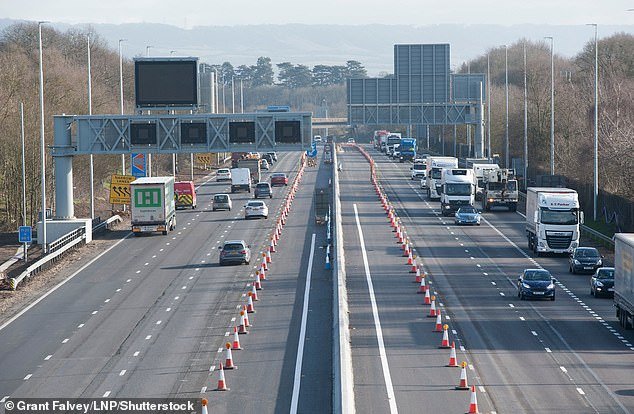Now the AA says drivers should AVOID stopping on smart motorways over safety fears… even if their car tyres are shredded
- Edmund King told of the ‘horrific’ distress calls from drivers who break down
- His comments came as probe into the safety of smart motorways began
- Mr King added it was a ‘scandal’ that some smart motorways had been rolled out without any of the radar technology designed to detect broken down vehicles
Driving with a burst tyre or smoking engine is safer than stopping on smart motorways, the AA president warned yesterday.
Speaking to MPs, Edmund King told of the ‘horrific’ distress calls patrols get from drivers who break down on the controversial roads.
His alarming comments came during a transport committee hearing as its probe into the safety of smart motorways began. These roads have their hard shoulders converted into extra lanes, meaning motorists can become marooned in live traffic.
Giving evidence to the committee, Mr King said: ‘The official advice is: if you do stop in the live lane, keep your seatbelt on, put your hazards and other lights on, and dial 999. It’s an emergency.
‘It is horrific the fear that comes through on the calls we get from breakdowns.
‘It’s just atrocious and we should not be putting people in a system that isn’t a safe system with that result. We’ve got to give people a way out of it and the advice I would give is: drive on [if you can].
‘Damage to your car may be expensive but it’s less than damage to yourself or your loved ones.’
He added: ‘If someone is breaking down and they’re on an all-lane running section [which have no hard shoulder] – so smoke coming out of the engine and a blown out tyre – I’ve got to say my advice would be don’t stop.
‘There is too much of a risk to stop. So even if it ruins your wheel, I would drive on to the next refuge area or emergency exit.’
Mr King added it was a ‘scandal’ that some smart motorways had been rolled out without any of the potentially life-saving radar technology designed to detect vehicles that had broken down.
Highways England has promised to have this fitted across the whole network no later than September next year, having brought the deadline forward from 2023.
But Huw Merriman, Tory chairman of the committee, was scathing about the promise to install the technology early, saying it was ‘six years too late’.
He added: ‘As a committee we’ve been rather badly stained with assurances by Highways England on this matter.
‘Back in 2016 this committee was told that going forward it [the technology] would be fitted to all new smart motorways and it will be retro-fitted. I think we had the same thing in 2019 when the CEO came before us.
‘We are therefore somewhat bemused to be told this is good news and it will be rolled out a year early by 2022, when it appears to us it’s six years too late. So I don’t have a great deal of faith in what I’m told.’
However, Mr King said that even if the technology was rolled out, there were concerns that it would not be capable of detecting some vehicles. He told MPs: ‘It will give an extra level of detection but it’s not perfect and it depends how control centres [scanning the network with cameras] react to it.’
Referencing a Highways England report, Mr King added that the technology might not be effective at detecting low cars – such as the Mazda MX5 – so it wasn’t ‘fail safe’.
And it takes 17 minutes on average for broken down motorists to be spotted before the alarm is raised – a system Mr King described as ‘horrific’.Nicholas Lyes, of the RAC, also told MPs the 17-minute wait was ‘not acceptable’.
‘Rather than dealing with minutes here we should be dealing in seconds,’ he said. ‘There should be technology that is automatically picking that up straight away.’
Other concerns included the lack of emergency refuges – which are currently up to a mile and a half apart on some smart motorways. Mr King said the AA wants more to be installed so they are no more than three-quarters of a mile apart.


